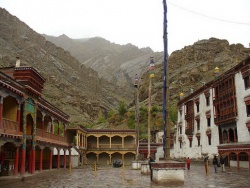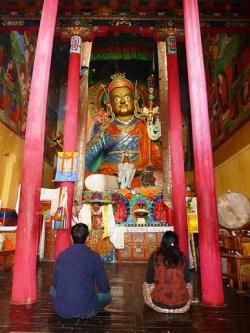Hemis Monastery
Hemis Monastery is a Tibetan Buddhist Monastery (gompa) of the Drukpa Lineage, located in Hemis, Ladakh (within the Indian state of Jammu and Kashmir).
Situated 45 km from Leh, the Monastery was re-established in 1672 by the Ladakhi king Sengge Namgyal.
The annual Hemis festival honoring Padmasambhava is held here in early June.
History
Hemis Monastery existed before the 11th century. Naropa, the pupil of the yogi Tilopa, and Teacher of the translator Marpa is connected with this Monastery.
A translation was made by A. Grünwedel (Nӑro und Tilo,: Festschrift Ernst Kuhn, München 1916) of Naropa's biography that was found in Hemis Monastery.
In this manuscript Naropa (or Naro) meets the "dark blue" (Skr.: nila: dark blue or black) Tilopa (or Tillo), a tantric master, who gives Naropa 12 "great" and 12 "small" tasks to do in Order to enlighten him to the inherent Emptiness/illusoriness of all things.
Naropa is depicted as the "abbott of Nalanda" (F. Wilhelm, Prüfung und Initiation im Buche Pausya und in der Biographie des Naropa, Wiesbaden 1965, p. 70), the university-Monastery in today's Bihar, India, that flourished until the sacking by Turkish and Afghan Muslim forces.
This sacking must have been the driving force behind Naropa's peregrination in the Direction of Hemis.
After Naropa and Tilopa met in Hemis they travelled back in the Direction of a certain Monastery in the now no longer existing kingdom of Maghada, called Otantra which has been identified as today's Otantapuri.
Naropa is consered the founding father of the Kagyu-lineage of the Himalayan Esoteric Buddhism. Hence Hemis is the main seat of the Kagyu Lineage of Buddhism.
In his 1894 travel book, Russian journalist Nicolas Notovitch claims Hemis as the origin of an otherwise unknown gospel, the Life of Saint Issa, Best of the Sons of Men, in which Jesus is said to have traveled to India during his "lost years."
According to Notovitch, the work had been preserved in the Hemis library, and was shown to him by the Monks there while he was recuperating from an injury.
When the abbot later denied all Knowledge of such a text, Notovitch (in a series of exchanges with F. Max Mueller) hinted that the lamas would have good reason to lie about the subject.
Scholars consider Notovitch's book a hoax. Though Novotovitch's claims were supported by Swami Abhedananda (1866-1939) of the Ramakrishna Mission.
Norbert Klatt left open the possibility that Notovitch had genuinely been shown Tibetan texts relating to Jesus - but these were Tibetan Gospel portions translated by Heinrich August Jäschke decades earlier.
Hemis Festival
The Hemis festival is dedicated to Lord Padmasambhava (Guru Rimpoche) venerated as the Dance Performance at Hemis Monastery representative reincarnate of Buddha.
He is believed to have been born on the 10th day of the fifth month of the Monkey year as predicted by the Buddha Shakyamuni.
It is also believed that his Life Mission was, and remains, to improve the Spiritual condition of all living beings.
And so on this day, which comes once in a cycle of 12 years, Hemis observes a major extravaganza in his memory.
The observance of these sacred Rituals is believed to give Spiritual strength and good health.
The Hemis festival takes place in the rectangular courtyard in front of the main door of the Monastery.
The space is wide and open save two raised square platforms, three feet high with a sacred pole in the center.
A raised dias with a richly cushioned seat with a finely painted small Tibetan table is placed with the ceremonial items - cups full of holy water, uncooked rice, tormas made of dough and butter and Incense sticks.
A number of musicians play the traditional Music with four pairs of cymbals, large-pan drums, small trumpets and large size wind instruments.
Next to them, a small space is assigned for the lamas to sit.
The ceremonies begin with an early morning Ritual atop the Gompa where, to the beat of drums and the resounding clash of cymbals and the Spiritual wail of pipes, the portrait of "Dadmokarpo" or "Rygyalsras Rimpoche" is then ceremoniously put on display for all to admire and worship.
The most Esoteric of festivities are the mystic mask dances.
The Mask Dances of Ladakh are referred collectively as chams Performance. Chams performance is essentially a part of Tantric tradition, performed only in those gompas which follow the Tantric Vajrayana teachings and the Monks perform tantric worship.

